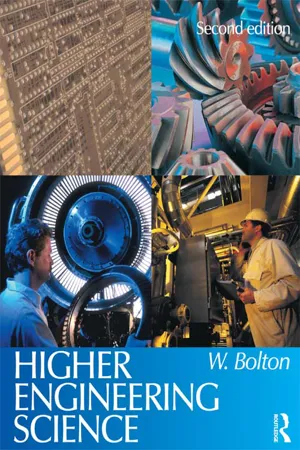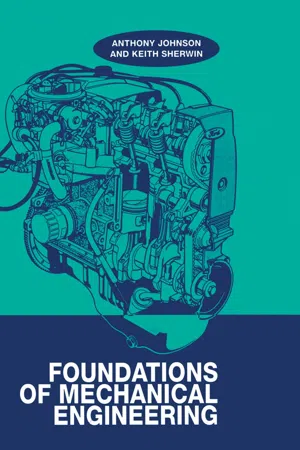Physics
Circular Motion
Circular motion refers to the movement of an object along a circular path. It involves a constant change in direction, even if the speed remains constant. The centripetal force, directed towards the center of the circle, is responsible for keeping the object in circular motion.
Written by Perlego with AI-assistance
8 Key excerpts on "Circular Motion"
Learn about this page
Index pages curate the most relevant extracts from our library of academic textbooks. They’ve been created using an in-house natural language model (NLM), each adding context and meaning to key research topics.
- eBook - ePub
- Alan Hendrickson(Author)
- 2012(Publication Date)
- Routledge(Publisher)
Figure 7.4c ). Mathematically, centripetal acceleration equalsFigure 7.4 Illustration of the terms involved in: a. Angular and linear displacement, b. Angular and linear speed and acceleration, c. Tangential and centripetal acceleration. (In both b. and c. rotational speed and acceleration are indicated in an easily understood way. The actual vectors for rotational velocity and acceleration would be shown by arrows along the axis of rotation, straight out of the page.)Newton’s second law states that force is required to accelerate mass, and so a centripetal force can be defined.a=c e n t r i p e t a l= rv 2rω 2F= mc e n t r i p e t a la= m rc e n t r i p e t a lω 2If you were to tie a weight to a string and spin it around above your head, the tension in the line would equal Fcentripetal . The cohesive forces within the steel of a shaft supply Fcentripetal , keeping the shaft from flying apart as it spins (though there are limits to the speed it can withstand). And a free-standing prop set on a turntable could slide outward, or away from the axis of rotation, if the turntable spins fast enough so that Fcentripetal exceeds Fstatic friction - eBook - ePub
Biomechanics of Human Motion
Applications in the Martial Arts, Second Edition
- Emeric Arus, Ph.D.(Authors)
- 2017(Publication Date)
- CRC Press(Publisher)
7Kinematics in Angular Motion
In this chapter, the author describes almost the same physical properties, characteristics regarding to rotational (angular ) motion. Besides distance, displacement, velocity, and acceleration, which have been described in Chapter 6 , other physical properties such as inertia, and different variables including tangential, centrifugal, and centripetal accelerations related to angular motion will be described in this chapter. The reader should know the following (information) facts related to angular motion. Any object/mass that is going through a uniform Circular Motion with a constant speed will be accelerated by the force driving it because a rotary motion is related to acceleration, velocity, and direction. How should be this understood? The object/mass basically has nothing to do with speed, but has to do with velocity. Since the velocity is a vector that has both magnitude and direction , a change in either the magnitude or the direction constitutes a change in the velocity.So, the conclusion of the above statement is that an object moving in a circle at constant speed is indeed accelerating. It is accelerating because the direction of the velocity vector is changing. If the magnitude of the velocity is changing, then acceleration occurs too. Putting this in simple words, the rotary motion constitutes a change in direction even if that direction is a perfect circle, and if the rotation is going on and on, it still constitutes a change of direction.7.1 DISTANCE AND DISPLACEMENT
When a body rotates in a 2-D plane, the rotation is characterized by the fact that the rotating body (its external point) moves around the perimeter of a circle or a cylinder at the same distance from the center of rotation. The rotating body describes a certain angle that can be measured by angles or radians. - eBook - ePub
- W. Bolton(Author)
- 2015(Publication Date)
- Routledge(Publisher)
Chapter 23 Circular Motion23.1 Introduction
This chapter is concerned with motion in a circle. Velocity is a vector quantity and has both size and direction. Thus, there is a constant velocity if equal distances are covered in the same straight line in equal intervals of time. Acceleration is the rate of change of velocity. Thus, there will be an acceleration if a velocity changes either as a result of equal distances in the same straight line not being covered in equal times or, if equal distances are being covered they are not in the same straight line, i.e. there is a change in direction. This is what happens with Circular Motion where we can have equal distances round the circumference of the circular path covered in equal times, i.e. constant speed, but the velocity is changing because the direction is continually changing and so there is an acceleration.23.2 Centripetal acceleration
Figure 23.1 Motion in a circleConsider a point object of mass m rotating with a constant speed in a circular path of radius r (Figure 23.1(a) ). At point A the velocity will be v in the direction indicated. At B, a time t later, the velocity will have the same size but be in a different direction. If the direction has changed by the angle θ in time t , then the amount by which the velocity has changed can be obtained by resolving the velocity at B into two components, one in the same direction as the velocity at A of v cos θ and the other at right angles to it of v sin θ , i.e. along the radial direction AC. The acceleration in the direction of the velocity at A is thus (v cos θ 2 v )/t = (cos θ - 1)v/t. The acceleration at an instant, rather than the average over the time t , is obtained by considering the value the average value tends to as we make t small and hence θ small. So, since cos θ tends to 1 as θ tends to 0, (1 - cos θ ) tends to 0. Hence, the instantaneous acceleration in the direction of the velocity at A tends to 0. As sin θ tends to δθ , the acceleration in the direction AC = (v sin θ - 0)/t tends to vδθ /δt . But vδθ /δt is the rate at which the angle is covered, i.e. the angular velocity ω - eBook - ePub
- William Bolton(Author)
- 2012(Publication Date)
- Routledge(Publisher)
19 A 200 mm diameter drive pulley rotates at 5 rev/s. It drives, via a belt drive, another pulley. What diameter will this need to be if it is required to rotate a shaft at 2.5 rev/s?4.4.4 Combined linear and angular motionConsider objects which have both a linear motion and angular motion, e.g. a rolling wheel. For a wheel of radius r which is rolling, without slip, along a straight path (Figure 4.24 ), when the wheel rotates and rolls its centre moves from C to C′ then a point on its rim moves from O to O′. The distance CC′ equals OO′ But OO′ = rθ. Thus:Figure 4.24 Rolling wheelhorizontal distance moved by the wheel x = rπ [31] If this movement occurs in a time t, then differentiating equation [31 ]:and thus:horizontal velocity vx = rω [32] where ω is the angular velocity of the wheel. Differentiating equation [32 ] gives:and thus:
where a is the angular acceleration.horizontal acceleration = ra [33] 4.5 Force and linear motionIn considering the effects of force on the motion of a body we use Newton’s laws.Newton’s laws can be expressed as:First lawA body continues in its state of rest or uniform motion in a straight line unless acted on by a force.Second lawThe rate of change of momentum of a body is proportional to the applied force and takes place in the direction of the force.Third lawWhen a body A exerts a force on a body B, B exerts an equal and opposite force on A (this is often expressed as: to every action there is an opposite and equal reaction).Thus the first law indicates that if we have an object moving with a constant velocity there can be no resultant force acting on it. If there is a resultant force, then the second law indicates that there will be a change in momentum with:
For a mass m which does not change with time:[34] dv/dt is the acceleration. The units are chosen so that the constant of proportionality is 1 and thus the second law can be expressed as:F = ma [35] If a body of mass m is allowed to freely fall then it would fall with the acceleration due to gravity g. The force acting on the freely falling object is thus mg and this is termed its weight - eBook - ePub
- Richard Gentle, Peter Edwards, William Bolton(Authors)
- 2001(Publication Date)
- Newnes(Publisher)
For the first part of this problem, the initial and final angular velocities are known, as is the time taken for the deceleration. The equation to use is therefore:First it is necessary to put the initial angular velocity into the correct units. One revolution is equal to 2π radians and so 2600 revolutions equals 16337 radians. This takes place in 1 minute, or 60 seconds and so the initial angular velocity of 2600 rev/min becomes 272.3 rad/s.Hence For the second part the equation to use isThis is not the final answer as it is the number of revolutions that is required. There are 2π radians in one revolution and so this answer needs to be divided by 2 3.141 59, giving a value of 216.7 revolutions .Motion in a circle
Angular motion can apply not just to objects that are rotating but also to objects that are moving in a circle. An example of this is a train moving on a circular track, as happens in some underground systems around the world. The speed of such a train would normally be expressed in conventional terms as a linear velocity in metres per second (m/s). It could also be expressed as the rate at which an imaginary line from the centre of the track circle to the train is sweeping out an angle like the hands on a clock, i.e. as an angular velocity. The link between the two is(4.1.14)Returning to the original definition of acceleration as either a change in the direction or the magnitude of a velocity, it is apparent that the train’s velocity is constantly changing and so the train is accelerating even though it maintains a constant speed. The train’s track is constantly turning the train towards the centre and so the acceleration is inwards. The technical term for this is centripetal acceleration. It is a linear acceleration (i.e. with units of m/s2 ) and its value is given by(4.1.15)The full importance of this section will become apparent in the next section, on dynamics, where the question of the forces that produce these accelerations is considered. For the time being just imagine that you are in a car that is going round a long bend. Unless you deliberately push yourself away from the side of the car on the outside of the bend and lean towards the centre, thereby providing the inwards force to accompany the inward acceleration, you will find that you are thrown outwards. Your body is trying to go straight ahead but the car is accelerating towards the geometrical centre of the bend. - eBook - ePub
- John Bird(Author)
- 2019(Publication Date)
- Routledge(Publisher)
Chapter 18 Acceleration Why it is important to understand: Acceleration Acceleration may be defined as a ‘change in velocity’. This change can be in the magnitude (speed) of the velocity or the direction of the velocity. In daily life we use acceleration as a term for the speeding up of objects and decelerating for the slowing down of objects. If there is a change in the velocity, whether it is slowing down or speeding up, or changing its direction, we say that the object is accelerating. If an object is moving at constant speed in a Circular Motion – such as a satellite orbiting the earth – it is said to be accelerating because change in direction of motion means its velocity is changing even if speed may be constant. This is called centripetal (directed towards the centre) acceleration. On the other hand, if the direction of motion of the object is not changing but its speed is, this is called tangential acceleration. If the direction of acceleration is in the same direction as that of velocity then the object is said to be speeding up or accelerating. If the acceleration and velocity are in opposite directions then the object is said to be slowing down or decelerating. An example of constant acceleration is the effect of the gravity of earth on an object in free fall. Measurement of the acceleration of a vehicle enables an evaluation of the overall vehicle performance and response. Detection of rapid negative acceleration of a vehicle is used to detect vehicle collision and deploy airbags. The measurement of acceleration is also used to measure seismic activity, inclination and machine vibration - eBook - ePub
- A. D. Johnson(Author)
- 2017(Publication Date)
- CRC Press(Publisher)
fraction of circumference × total circumference== 420mm1 .5 × 560 π2 π2.6.3 Angular velocity
A car travelling along the road at a steady velocity possesses linear velocity measured in m/s. The wheels are also rotating at a steady velocity and their ‘angular velocity’ is measured in rad/s and is defined as ‘the rate of change of angular displacement compared to elapsed time’ and may be denoted by the symbol ω (omega).Angular velocity parallels linear velocity in that it shares the same concepts of average velocity and constant velocity, but it must be noted that these now refer to rotational velocities and are defined in appropriate units.If a chalk mark on a bicycle wheel takes a time t to rotate through an angle θ , then the average angular velocity isConstant angular velocity means that equal, consecutive angular displacements (rad) are covered in equal intervals of time. The bicycle wheel would, therefore, rotate at a non-varying velocity.ω =θ t=angular displacement time ( 2.6 )Angular velocity is related to the ‘frequency of rotation’, or the number of revolutions made per second. Since there are 2π radians in one revolution, then n revolutions per second will have an angular velocity of 2πn rad/s, as follows:Hence1 rev/s = 2 π rad/s2 rev/s = 2 π × 2 rad/s3 rev/s = 2 π × 3 rad/sn rev/s = 2 π × n rad/sangular velocity = ω = 2 π n rad/s ( 2.7 )In many cases angular velocity is quoted in the form of revolutions per minute, which requires a modification of equation (2.7) , as follows:ω =rad/s2 π n60 ( 2.8 )where n is expressed in rev/min.Example 2.13 A flywheel rotates at 3000 rev/min. Find its angular velocity in rad/s. SolutionThe angular velocity can be found by using equation (2.8) :ω ==2 π n60= 314rad/s2 π × 3000602.6.4 Angular acceleration
When traffic lights turn green a car steadily builds up its velocity after being at rest. The car experiences linear acceleration. The wheels are also stationary when the lights change to green and they also steadily build up their velocity. Their angular velocity increases second by second and can be said to possess ‘angular acceleration’, denoted by α (alpha). The units of angular acceleration are radians/second/second (rad/s2 - eBook - ePub
- Clifford Matthews(Author)
- 2011(Publication Date)
- Wiley-Blackwell(Publisher)
a ) Third law Every action produces an equal and opposite reaction. 5.3.1 Comparisons: Rotational and Translational Motion 5.4 Simple Harmonic Motion (SHM)A particle moves with SHM when it has constant angular velocity (ω). The projected displacement, velocity, and acceleration of a point P on the x.y axes are a sinusoidal function of time (t ).Figure 5.2 Simple harmonic motionAngular velocity (ω) = 2π N/60 where N is in rev/minPeriodic time (T) = 2π/ ωVelocity (v ) of point A on the x axis is v = ds /dt = ωr sin ωtAcceleration (a ) = d2 s /dt 2 = dv /dt = −ω2 r cos ωt5.5 Understanding AccelerationThe dangerous thing about acceleration is that it represents a rate of change of speed or velocity. When this rate of change is high it puts high stresses on engineering components, causing them to deform and break. In the neat world of physical science, objects in a vacuum experience a constant acceleration (g ) due to gravity of 9.81m/s2 – so if you drop a hammer and a feather they will reach the ground at the same time.Unfortunately, you won't find many engineering products made of hammers and feathers locked inside vacuum chambers. In practice, the components of engineering machines experience acceleration many times the force of gravity so they have to be designed to resist the forces that result. Remember that these forces can be caused as a result of either linear or angular accelerations and that there is a correspondence between the two as shown on the following page.
5.5.1 Design HintLinear acceleration Angular acceleration When analysing (or designing) any machine or mechanism think about linear and angular accelerations first – they are always important.5.6 Dynamic BalancingVirtually all rotating machines (pumps, shafts, turbines, gearsets, generators, etc.) are subject to dynamic balancing during manufacture. The objective is to maintain the operating vibration of the machine within manageable limits.







